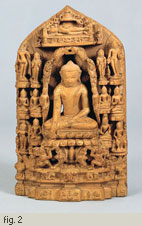This small (h. 19.7 cm.) stele depicts the historical Buddha Shakyamuni surrounded by scenes from his life . Like the Tara , this important sculpture is also carved in pyrophyllite and has traces of gilding. The origin of this work, too, has been the subject of much debate, and scholars have assigned it to both Burma and eastern India.
12 The Asia Society plaque and others like it were once ascribed to Burma largely because the central Buddha, shown seated with his right hand reaching down to touch the earth, has a peculiarly short neck, the chin tucked as if set with determination. This unusual feature was thought to be of Burmese origin, but Hiram Woodward, Jr., and others have demonstrated that some Buddha images of the same style and iconography can be specifically associated with Bodh Gaya, the site of the Buddha's enlightenment. As described in greater detail in the following section dealing with
Bodh Gaya, such short-necked Buddha images are likely to have been produced as mementos of pilgrimage.
13









